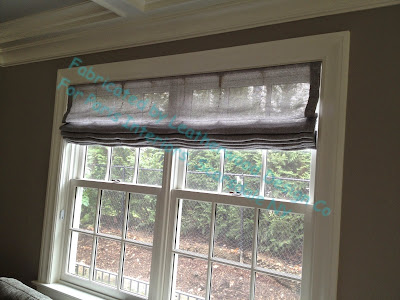It's taken me so long because I did not take enough pictures during the fabrication. We were spending our time trying to figure out an effective method so I mostly forgot about photos. So, here I am, and I'm going to work on it while I watch old Dr. Who episodes.
My client chose this Pierre Frey applique fabric for four pairs of drapery panels, and asked us to cut out the pieces of the motif and re-applique them to a sheer linen to create London shades underneath.
There were an awful lot of pieces to each motif, some with inner cutouts.
Wonder Under was the perfect product for this project. I ironed it onto the back side of the fabric area that I wanted to cut out. The blue satin stitch outlining each piece actually made it easier to do the cutting. A little snip scissor got into the cutout areas. It took about an hour for each of the four shades just to do the cutting.
After cutting out all the pieces and peeled off the paper backing, I recreated the layout on the linen sheer, using a tracing underneath as a template, then pressed the pieces in place. I don't have a photo of the paper tracing; I drew it on graph paper with black Sharpie and then turned it upside down so the black wouldn't come off on the sheer.
I held it up to the light- and right off the bat I could see that it was spectacular! Any skepticism I had had about the project instantly disappeared.
The next step was to sew the applique. Each piece was hand-sewn to the linen sheer by Camille, my amazing hand-sewing expert friend- and it was just as lengthy a process as you probably imagine. I don't remember exactly but I think each shade took 3 hours of hand-sewing, and that's before making the shade itself!
Now to turn it into a shade. I made a mockup of the actual shade-to-be out of lining, and pinned a plastic tracing of the motif over the shade so we could determine placement while the mockup hung in the client's window.
We chose this more old-fashioned style of London shade in order to keep the fullness down and also to keep the tails from drooping longer than the center. This London shade style uses single or knife pleats instead of double or inverted box pleats. It creates a more compact silhouette.
The final shades had the exact shape I had mocked up- yay!
After they were installed I realized that they needed top welting to fill in the small gap between the fabric and the window frame. I went back to the house with some ivory welting already made up, took the shades down, and applied the welting with double-sided tape. I don't think you can even see it in the pictures. But I know it's there.
The draperies are made with two-finger French pleats, three inches long.
Next time I'm back at this home, I'll take pictures of the fabulous custom-made hardware that the homeowner designed to meet a particular challenge: because the walls are Venetian plaster, the brackets had to be installed on the molding. Her solution to get the draperies up and out is brilliant- more on that another time!

.jpg)



























